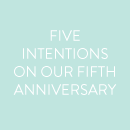Marvelous Money: The emergency fund
Hello, friends! Thank you SO much for your feedback on my first Marvelous Money post! I’ve noted all of your questions and thoughts and look forward to discussing them together over the next few weeks. For our first nuts and bolts post, I wanted to begin with a topic many of you brought up: the emergency fund.
Let me be clear: I am NOT an expert on personal finance, and so there are very few things that I will ever say with absolute certainty on the subject. Here’s one: If you don’t have an emergency fund, you need one. Several of you commented that you fell back on credit card debt when unexpected expenses came up. We can’t change the past, but we CAN change the future, so let’s just agree that from this point forward, that is not going to be an option for any of us, ever. Okay?
Wonderful! Now let’s talk emergency fund.
An emergency fund is for:
— paying for something you had no way of knowing was coming and that would have a major impact on your family if you don’t cover it. Examples include paying the deductible on insurance (health/homeowner’s/car), medical bills from an accident or unforeseen medical problem, or a major problem with a necessary car.
An emergency fund is not for:
— buying a piece of clothing that’s on sale, a couch (or even a washer/dryer), a car, or a vacation.
— building wealth (more about this below).
What does an emergency fund look like? Almost every source suggests a fully funded emergency fund should cover three to six months of expenses. If you have a steady, secure job (think honestly about this) that you’ve held for a while and everyone in your family is healthy, then three months might be sufficient. If you are self-employed, work in a sales or commission-based job, and/or have chronic health issues, I’d lean toward the six month mark. For young people in this economy, I’d lean toward the six month mark.
Your emergency fund should cover expenses, not income. If, say, you lost your job, you’d obviously try to cut back in as many areas as possible, but you’d still have to have somewhere to live, have something to eat, and continue to make any recurring payments like a car or student loan. For most families, an emergency fund ranges from between $10,000 to $30,000. Right now, John and I consider our emergency fund fully funded with about five months of bare bones expenses.
How did we do it?
— We established an emergency fund savings account in January 2010, and each contributed an initial lump sum (I believe about $2,000 each, from our high school and college savings). If having that type of money to use seems so far from your reality, it’s okay! It will just take you a little longer to get to the fully funded mark.
— Next, we started saving. In 2010, we each contributed $75 a month into the fund. In 2011, we actually decreased our monthly contribution to $50 each and put the difference (and then some) into our wedding savings account.
— In December 2011 I received a very generous Christmas gift from my grandmother that allowed us to complete our fund. We were very fortunate to receive this gift, and gratefully recognize it made the process easier for us. However, if you’re tempted to shrug off our efforts, I’d humbly remind you that we made the decision to put that money into our emergency fund instead of, say, going on a vacation, or buying a new couch. (And trust me, when we first graduated from college and our entire living room of furniture consisted of ONE three-year-old loveseat from Ikea, we really wanted a new couch.) There were other virtuous things we could have done with the money, like pay down our debt, but given the experience we had gone through with John’s unemployment, we wanted to make sure we were secure should we ever face that situation again.
In order to make the process as painless as possible, we set up an automatic monthly transfer from the checking account where our paychecks are deposited into our emergency fund savings account. If you’re able to set up a transfer directly from your paycheck, even better! I think you’ll be surprised to find that you don’t much miss it if it’s not there to spend. Even if it’s only $50, transfer it from EVERY paycheck, and resolve not to touch it. Just pretend it’s not there!
Over time, increase the amount that you’re saving. It might take years, but eventually you’ll have a very comfy cushion to fall back on, should you ever need it. And really, it’s okay if it takes years! Just the mere existence of a cushion allows you to focus on other things (and keep building a bigger cushion), because you’re not constantly being sent back to square one/back into debt the minute something unexpected happens.
Saving for an emergency fund is NOT fun — or at least, it wasn’t for me, and I am someone who really loves saving :) A good emergency fund is B-O-R-I-N-G. It has to be an account with easy access and basically zero risk, which typically means a standard savings account. With our current low interest rates (0.75% on mine right now), your returns are going to be tiny even on a large chunk of money.
Worse, there’s no anticipation of saving up for something fun, like a vacation or a wedding. At the end, you won’t have anything to show for your work, like a house, since most of us don’t go around flashing our bank statements. The motivator here is lifelong financial security, which, while AMAZING when you step back and think about, is not as gratifying in the short term.
BUT, the AWESOME thing about an emergency fund, is that once you fund it, you can check it off and move on, unlike, say, retirement savings. Even if you are forced to dip into your fund, it’s unlikely you’d need to wipe it out in one go. And if, at the end of your life, you still have a fully funded emergency fund? Well, you’ll just have more to give away — not such a bad problem to have :)
Here are my three best reasons why YOU (yes, you!) should get started with an emergency fund today:
1) It takes no time. You just need a savings account and an automatic transfer, and you can set it and forget it. There’s no need to monitor the account closely.
2) It takes no experience. Again, the investment tool is very simple and stable, so there’s almost no way to do it “wrong” — unless you don’t do it at all.
3) It takes not very much money. Unlike, say, paying off debt, it’s okay if you go slower on this one. I would suggest making an initial contribution of $250 or $500, or $1000 if you can swing it, but from there, start with whatever monthly contribution is comfortable for your budget and try to increase the amount every year.
YOU can do this friends! And you will feel so good when you do, I promise!!
So tell me: Have I convinced you? Do you already have a separate emergency fund, fully funded or not? If fully funded, how long did it take you to get there? If not, are you going to start one today? :) Any questions I didn’t answer?
As a reminder, my advice is meant for someone in a generally stable financial position. If you are facing serious financial problems or significant debt, I would suggest seeking professional help, as there are likely other steps you should prioritize.





















My problem with starting an emergency fund/savings account has always been that I can easily transfer money out of it and into my checking account with a few clicks of the mouse, or now, even a few swipes of my finger. I think that I’m going to move a serious savings account to a separate bank that I can’t transfer directly to my checking from. This way I’ll be more serious about strictly living off my checking account.
Emily, you are so right! And I wish I had taken saving for the emergency fund more seriously. I’m in a tight situation now where I’m planning for and paying for half my wedding, and I have to have a kidney transplant, most likely between now and June (the wedding is June 15). I just found out from my company that I can only take unpaid leave for this procedure if I don’t have any other leave left to use. This unpaid leave is supposed to be looked at as a prize because I would get to keep my job afterwards. AND the vendors need to be paid in the next 3 months. Such an inconvenient situation. Wish I had an emergency fund that was funded better.
LOVE THESE POSTS, EM!! This is such an important one!! It’s SO easy to get discouraged when you save up and then immediately afterwards or during saving, an emergency happens. Murphy’s Law, I suppose? Before Steven and I were married, we each started saving money together to work on our emergency funds. Yet, wouldn’t you know it, as soon as we reached our $1000 goal (following Dave Ramsey’s baby steps), SOMETHING would happen! OVER AND OVER AGAIN, I may add! It seemed like a never ending cycle of save, depleat, save up again, depleat. An issue with his car, an issue with my car, and right when we got married- the AC unit in our house kerplunked and wiped us out completely. Welcome to marriage & homeownership :) We borrowed money from his dad, who was gracious enough to help us avoid interest from the AC unit purchase. (It was July in NC, so yes, that qualified as an emergency!) The whole thing cost us around 5k and I learned quickly the value of saving thousands of dollars (not just hundreds of dollars) ‘just in case!’ We worked hard to pay his dad back quickly for loaning us the money for that, and have since then increased the amount of money we put towards savings! But, my point is–just stay on track. Bite the bullets when they happen and keep on truckin! And if some sort of emergency hasn’t happened in your world for a WHILE, (knock on wood) it’s probably coming! Baby steps are a great way of approaching it because you can just take it a month at a time. Never count on ‘bonus checks’ or ‘gifts’-while you’re building, just toss them into that emergency fund (or to debt, first) because once you’re savings account is growing into months of savings, you’ve got that cushion and you can breath! If I can do it, anyone can do it :) Oh-and the exciting thing about it for us is that we’ve been able to see how quickly we have been able to build our several months of savings (over the course of 2.5 years-which, I think is reasonable and you may be able to go about it even quicker) so that gives us motivation to continue that kind of savings for a new (to us) car (!!!) All in good (PATIENT) time!
I prefer to term that the period of John’s “pre-employment,” not “unemployment.”
@Emily Emailed you :)
@Jewel I am so sorry to hear about your situation. Wishing you all the best with your surgery and wedding planning!!
@Megan Whoo, that’s a tough way to start an emergency fund! But good for you guys for persevering!!
I would definitely consider locking this into a CD for at least 1 year. You will earn a higher yield than your savings account and it only makes it harder to spend it.
It seems like an easy step to take, to reward yourself slightly for the hard work you have put in.
Any recommendations on where to save the emergency fund?
[…] be better prepared for that if it ever happens again. I highly recommend Em for Marvelous’s post on this topic and her whole Marvelous Money series, […]